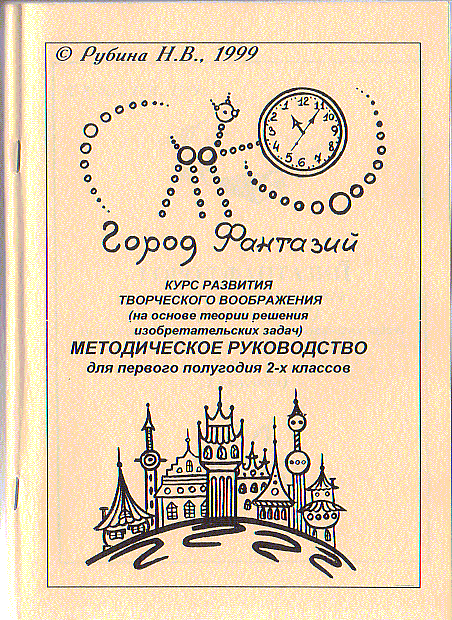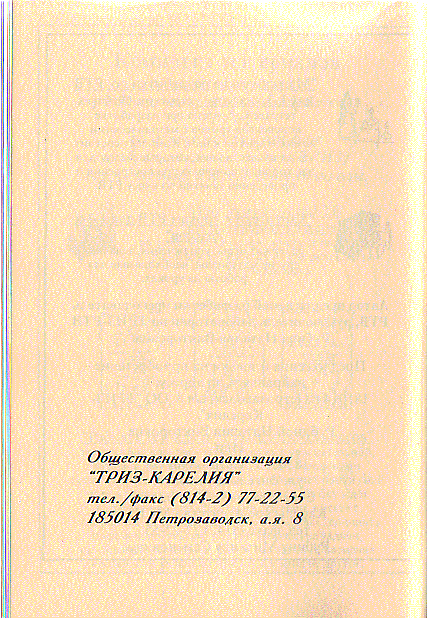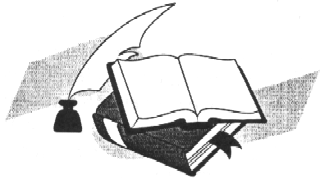Course of Creative Imagination Development (CID) Based on TRIZ, 2nd Grade, 1st Semester, Methodical Guide-Book
English translation by Irina Dolina (Tokyo, Japan) Apr. 2, 2001
Technical Editing by Toru Nakagawa (Osaka Gakuin Univ.) Jul. 15, 2001
List of posting in this Home Page:
| Jul. 17, 2001 | 2nd Grade/1st Semester "Fantasy City" | Preface, Intro., Topics 1-6 (Finish) | Guide-Book | Workbook |
Editor's Note:
Please refer to the Editor's Preface (by T. Nakagawa) and the Author's
Introduction (by N. V. Rubina) on the top page of this Course textbook
series.
| Top of this page | Contents | Front Cover | Invitation (Preface) | Symbol marks | Weekly Topic Planning | CID Course Top Page |
Contents
of the CID Course, 2nd Grade, 1st Semester Course
Top Page:
| Book Title;
Grade/Semester |
Contents | Guide-
Book |
Work-
book |
Posted
date |
| "Fnatasy
City"
2nd Grade,
|
Preface and Weekly Topic Planning | Jul. 17,
2001 |
||
| Introduction. Acquaintance
with Fantasy City
(Introductory Lesson) |
Jul. 17,
2001 |
|||
| 1. Card Index - First step on the way to creativity | Jul. 17,
2001 |
|||
| Sdventures in Fantasy City
2. Morphological Box (Method of fantastic subtraction) |
Jul. 17,
2001 |
|||
| 3. Unususal Inhabitants of Fatasy
City
(Animation Method) |
Jul. 17,
2001 |
|||
| 4. Magic shop
(Methods of focal objects) |
Jul. 17,
2001 |
|||
| 5. Methods of Making Images
(1. To increase - to shrink) (2. To assemble - to disassemble) (3. Upside down) (4. To speed up - to slow down) (5. Transit in time) (6. Binomial of fantasy) |
Jul. 17,
2001 |
|||
| Topic 6. Reports from Fantasy
City
(Fantogram) References & Card Index |
Jul. 17,
2001 |
(C) N.V.Rubina,
I. Dolina, T. Nakagawa, 2001
Fantasy City
Course
of Creative Imagination Development (CID)
(Based on Theory of Inventive Problem Solving
(TRIZ))
METHODICAL GUIDE-BOOK
Second Grade, First Semester
Natalia V. Rubina
 |
 |

Fantasy City
Course
of Creative Imagination Development (CID)
(Based on Theory of Inventive Problem Solving
(TRIZ))
METHODICAL GUIDE-BOOK
Second Grade, First
Semester

Natalia V. Rubina
Petrozavodsk 1999
English Translation by Irina Dolina, April 2, 2001
Technical Editing by Toru Nakagawa, July 15, 2001
The program of the CID course was elaborated and defined in Petrozavodsk in 1996. Six workbooks with special methodological recommendations (for each semester) were worked out. The program and all the methodological material were probated on the basis of the "TRIZ Laboratory" at the Petrozavodsk School #17.
This pamphlet introduces
the methodological instructions for the first semester of the CID second
grade ("Fantasy City").
"Fantasy City". Creative Imagination Development Course for the elementary school (The first semester of the second grade). Methodological instructions.
Reprints and distribution only by author's permission.
 |
Invitation
to Take a Trip
(Instead of Preface) |
Do you remember that
the city of your childhood was full of sun, birds’ singing, warm and loving
smiles? In this city there were fairy tales: kind kings, beautiful
princesses, noble knights… You couldn’t stop being surprised – the
world around you was changing all the time. One day doesn’t resemble
the other. It was very interesting to find out how this amazing world
was constructed!
To find out how his toy is constructed, a child disassembles it. (At your place you, probably, have many disassembled toys.) But the world is too large, it’s impossible to disassemble it, but it’s necessary to understand how it is arranged. The main aim of CID Course for the first grade “Fairy Tales School” was to develop the children’s system thinking. The major aim of the games and activities, combined in one topic, was to form the basis of the main notions of the operator system, to obtain skills for working with this method, to gain experience in using knowledge for solving inventive problems. Different methods of composing the fairy tales help to confirm the knowledge and to apply them to creativity.
The next step in the creative thinking development is to learn how to change the system surrounding us and predict its consequences. G. S. Altshuller (the author of TRIZ-CID-TRTL) at his classes used to ask to do the following activity-test: to make up a magic animal. Everything seemed so simple – an original fantastic idea was needed. However, as a rule, the kids presented either “rabbits with fox’s tails”, or something like the fairy-tales’ characters: dragons, mermaids and the like. Probably, in solving these problems, connected with designing original fantastic ideas, it was more logical to turn to science-fiction.
That was done by the science-fiction writers G. Altov (G. S. Altshuller’s pen-name) and P. Amnuel. As a result they have created a method, which systematized the basic means of designing fantastic ideas (Fantogram). Besides, other methods of creative thinking stimulation were described and successfully applied (e.g., Morphological Analysis, Method of Focal Objects, Operator CID, Brain Attack, Synectica and others). These methods became the basis of "the CID Course for the second grade", i.e., “Fantasy City”.
General plot of the course refers to the adventures of the characters, familiar to the children from “Fairy Tales School”, taking place in Fantasy City. The city is large and has a complicated social system that develops according to its own laws. It depends on the children how our cities will look like in the 21st century. That is why it is necessary to teach them to understand the arising problems and solve them without unnecessary and sometimes very expensive tests and mistakes.
The city is the part of a larger super-system. The city life is influenced by many factors: social (for example, the state, where the city is located), natural (climate, landscape and others). And the city in its turn changes the environment, contributes its own changes, not always favorable. Of course, it’s difficult for the children to understand the complicated problems. However, they have the ability to notice the creative problems around them, to master the basis of the method of solving them and to use this method to solve their school problems. “The CID Course for the third grade” will introduce the children to the methods of Inventive problem solving, will teach them to apply these methods for designing their creative and research projects.
Sometimes there are arguments: “Imagination and fantasy are given to a person by Nature and to help a child to design his own world is the same as to teach a bird to fly!” Of course, natural abilities are an amazing gift. However, think: who will fly farther – a person, who uses only his natural abilities or a sportsman, who uses a spring-board?
The methods of developing imagination are like a “spring-board” for the fantasy! The use of these methods helps not to waste time on unsuccessful tests, to feel unusual world outside the framework of stereotype, outside the borders of the mental inertia.
In this book the ideas of many TRIZ professionals are applied. For convenience the quotations from the original works are cited. It will save your time, and help to understand better the suggested CID methods and devices.
The author expresses deep gratitude to I. N. Murashkowska, A. A. Nesterenko, M. S. Gafitulin, M. S. Rubin, I. L. Vickentyev, N. N. Khomenko, V. I. Timohov, S. V. Sychov and to other TRIZ-CID professionals, whose works have contributed in preparing this CID Course. And, of course, the contribution of the 1st-to-3rd grade students of School #17 of Petrozavodsk is invaluable. Thank you, my little magicians!
Send your comments,
suggestions and applications for these CID-course workbooks and methodical
guide-books to the following address: 185014, Petrozavodsk, mail
box 8, “TRIZ- Karelia”.
Rubina N. V.
[Translation Note 1: CID-TRTL
For better
perception the following symbols are used in the methodical guide-book:
 |
- problems. For the first grade simple problems demanding answers "yes-no" are used. The major notions of the methods of solving problems are studied in the second and third grades. That is why the most suitable form for solving creative problems is a game "yes-no". The rules of the game are not difficult. After the problem is introduced the kids start to look for the solution by asking questions to which the teacher replies "yes" or "no". The aim of the game is to find a solution by asking as many questions as possible. |
 |
- activities. During these activities it is important that the kids understand how this or that notion may be used for solving the problems, for obtaining new ideas, etc. |
 |
- psychotechnical games. This is a specific part of the lesson. Kids may relax a little and turn to their inner world, the world of a child's fantasy. It goes without saying how important is the atmosphere of trust, friendliness in your small community. |
 |
- speech developing activities. We all know very well how easy to speak with a person who can ask interesting questions. CID classes are structured in a form of a dialogue, therefore actually any task is an exercise on speech developing. Nevertheless, devising their own riddles, proverbs, tales, the kid learns not only to say "full sentences", but develops a need to formulate his idea in such a way that he would be understood and his wits and humor be assessed. Describing various systems, solving unusual problems, the kids enrich their vocabulary all the time. |
 |
- designing a creative product. Don't be confused by an unusual term. "Creative product" is something finished, designed by the kids with the help of methods they study (a riddle, a proverb, a tale, a model of a toy, articles of natural materials and others). |
 |
- tasks-pictures. At the CID classes there are many activities like that because a new creative idea is often embodied in images, especially it refers to the kids with a strong visual representative system. Most of these tasks are unique stuff for a psychologist, for attentive parents, because in this pictures the inner world of a child is reflected as if in a mirror. |
Weekly Topic Planning
(2nd Grade, 1st Semester)
| Date | Topic | No. of hours | |
| September | 1st week | Introduction. Acquaintance with Fantasy City. | 1 hour |
| 2nd week | Topic 1. Card Index – First step on the way to creativity | 1 hour | |
| 3rd week | Adventures in Fantasy City:
Topic 2. Morphological Box (Method of fantastic subtraction) |
1 hour | |
| 4th week | Topic 3. Unusual Inhabitants of Fantasy City (Animation Method) | 1 hour | |
| October | 1st week
2nd week |
Topic 4. Magic Shop (Method of focal objects) | 2 hours |
|
November
December |
3rd week 4th week 1st week 2nd week 3rd week 1st week |
Topic 5. Methods of Making Images
Lesson 1. To increase – to shrink Lesson 2. To assemble – to disassemble Lesson 3. Upside down Lesson 4. To speed up – to slow down Lesson 5. Transit in time Lesson 6. Binomial of fantasy |
6 hours |
| 2nd week | Topic 6. Reports from Fantasy City (Fantogram) | 1 hour | |
|
3rd week |
DKR.
What to check:
|
1 hour |
|
| Top of this page | Contents | Front Cover | Invitation (Preface) | Symbol marks | Weekly Topic Planning | CID Course Top Page |
| Home Page | New Information | Introduction to TRIZ | TRIZ References | TRIZ Links |
| TRIZ News & Activities | TRIZ Software Tools | TRIZ Papers and Tech Reports | TRIZ Forum |
Last updated on Jul. 17, 2001. Access point: Editor: nakagawa@utc.osaka-gu.ac.jp